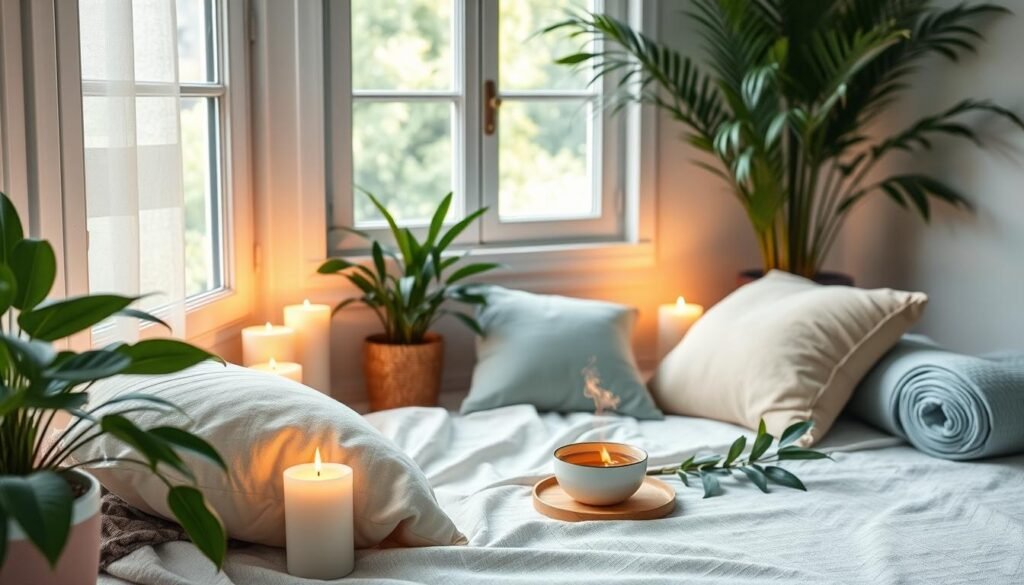About 31.1% of U.S. adults face anxiety disorders at some point. Unspecified anxiety disorder, often ignored, is a big concern. This piece will explore ways to handle it. We’ll look into mindfulness, exercise, and seeking help to manage symptoms. These strategies can help you take back control and improve your life.
Key Takeaways
- Unspecified anxiety disorder affects a significant portion of the U.S. population.
- Women are more likely to receive diagnoses of anxiety disorders compared to men.
- Effective coping strategies can significantly alleviate symptoms.
- Mindfulness and physical activity are proven techniques for managing anxiety.
- Professional support plays a crucial role in anxiety management.
Understanding Unspecified Anxiety Disorder
Anxiety is not just about worry. It’s a deep, ongoing problem that messes with daily life. People with anxiety face a tough time because of intense feelings. This leads to hardships. Unspecified anxiety disorder is common. It’s anxiety that doesn’t have a specific cause. Knowing about it is key for early help and good decisions.
What is Anxiety?
Anxiety is when you feel very worried or scared. These strong feelings can harm your health. Anxiety shows up in different ways. This includes generalized anxiety disorder, social anxiety disorder, and specific phobias. Understanding anxiety helps us cope better. It teaches us how to manage our mental health well.
Symptoms of Unspecified Anxiety Disorder
Symptoms of unspecified anxiety disorder can vary widely but commonly include:
- Emotional Signs: Persistent fear, feelings of restlessness, and difficulty concentrating.
- Physical Manifestations: Accelerated heartbeat, sleep disturbances, and muscle tension.
- Behavioral Changes: Avoiding social situations, changes in eating habits, and withdrawal from daily activities.
It’s important to recognize these symptoms. Often, it helps to use mental health methods like relaxation. Changing your lifestyle is also advised. Learning about this issue and talking about treatments is very helpful for those affected.
For more insights, explore unspecified anxiety disorder symptoms and coping.
Identifying Triggers for Anxiety
Knowing what sparks your anxiety is key to controlling it. Recognizing elements that make anxiety worse helps people prepare and reduce symptoms. Here, we explore common triggers and how to pinpoint personal ones.
Common Triggers Faced by Individuals
Everyday life is full of potential anxiety triggers. Among them are:
- Stress from work or school commitments
- Personal relationships and interpersonal dynamics
- Significant life changes, such as moving or changing jobs
- Health concerns or medical diagnoses
- Financial difficulties or economic instability
Facing these triggers can intensify feelings of anxiety. It’s important to recognize these stressors to manage anxiety well.
How to Recognize Personal Triggers
Spotting your specific anxiety triggers might take some introspection. Here are tips to help:
- Keep a Journal: Write down thoughts and feelings in stressful times to see patterns.
- Monitor Physical Reactions: Notice bodily signs when anxious to identify triggers.
- Talk with Supportive Friends or Family: Sharing experiences can provide insights into triggers.
- Engage in Therapy: A therapist can help find the root causes of anxiety.
Using anxiety self-help tips is beneficial in recognizing these triggers. Staying reflective and aware helps understand triggers better, improving anxiety management.

| Common Triggers | Possible Reactions |
|---|---|
| Work Stress | Increased heart rate, sweating |
| Relationship Issues | Feeling overwhelmed, irritability |
| Health Concerns | Panic attacks, sleeplessness |
| Financial Strain | Restlessness, excessive worry |
Focusing on specific triggers and reactions helps people manage their anxiety better. This comes with knowing effective anxiety coping mechanisms.
Coping Strategies for Unspecified Anxiety Disorder
Finding the right ways to deal with unspecified anxiety disorder is crucial. Using different techniques can help people handle their anxiety better. They can feel better and more in control of their lives by trying mindfulness, physical activity, and a balanced diet.
Mindfulness and Meditation Techniques
Mindfulness and meditation are key to lessening anxiety. They help people focus on the present, steering them away from anxious thoughts. By practicing deep breathing or using guided meditations, one can find relief. Making mindfulness a regular habit improves our ability to stay calm when stressed.
Physical Activity as a Coping Mechanism
Being active is a great way to fight off anxiety. Exercises like running, yoga, or brisk walks boost happy hormones. Research suggests staying active can be as good as medication for managing anxiety. Choosing fun activities makes sticking to an active life easier, which helps with anxiety.
Maintaining a Balanced Diet
Eating right is key to handling anxiety and feeling mentally strong. Foods full of omega-3s, magnesium, and vitamins can lower anxiety levels. Healthy eating affects our mood and stress heavily. Including diverse, wholesome foods in our diet supports our mental health and reduces anxiety triggers.
Using these strategies improves mental health and gives people power over their anxiety. Looking into effective treatment plans is also a great idea for extra support.
| Strategy | Benefits |
|---|---|
| Mindfulness & Meditation | Enhances present-moment awareness, reduces anxious thoughts. |
| Physical Activity | Releases endorphins, nearly as effective as medication for anxiety. |
| Balanced Diet | Improves overall mental health, supports stable mood levels. |
Relaxation Techniques for Anxiety Relief
Looking for ways to relax is key to handling stress and feeling better overall. Things like deep breathing and relaxing your muscles can really help with anxiety’s physical signs. These methods let you control your mental health and lessen stress daily.
Deep Breathing Exercises
Deep breathing is strong for easing stress. It makes you focus on your breath, calming your mind and body. It can slow your heart rate and lower your blood pressure. Doing these breathing exercises cuts down stress hormones and brings back calm.
- Find a comfortable position, either sitting or lying down.
- Close your eyes, if comfortable, and breathe in deeply through your nose, letting your belly expand.
- Hold it for a moment, then slowly breathe out through your mouth, letting go of tension.
- Keep this up for a few minutes, focusing on each breath.
Progressive Muscle Relaxation
Progressive muscle relaxation is great for easing anxiety. It’s about tightening and then relaxing different muscle groups. It helps you notice muscle tension and lets you release it on purpose. This helps you feel more relaxed overall.
- Tense your toe muscles for about five seconds.
- Slowly relax the muscles and feel the tension go away versus when it’s tense.
- Go through your legs, belly, arms, and face the same way.
Using these techniques every day can really improve how you handle stress. Deep breathing and muscle relaxation help control emotions and fight anxiety. It makes you more resilient.

Anxiety Management Techniques
Various strategies exist to handle anxiety, aiming to improve well-being. Key approaches include managing time well and setting clear boundaries. These practices help individuals to cope with anxiety better. This results in feeling more in control of their lives.
Time Management for Reducing Stress
Time management is essential for reducing anxiety. It helps avoid feeling overwhelmed. By organizing schedules, people can use their time more efficiently and lower stress.
Here are some practical time management tips:
- Creating a daily to-do list to prioritize tasks.
- Setting specific time limits for activities to maintain focus.
- Breaking larger projects into manageable steps.
- Utilizing calendars or planners to visualize upcoming responsibilities.
- Scheduling regular breaks to avoid burnout.
This advice can improve how individuals handle tasks. It leads to a clearer mind and less anxiety.
Setting Boundaries to Manage Anxiety Levels
Establishing boundaries is key to managing stress. It prevents becoming too stimulated or fatigued. By setting limits, people can balance their personal and professional lives better.
Effective boundary setting involves:
- Identifying personal limits in social and work situations.
- Communicating needs clearly to others.
- Avoiding overcommitment by saying “no” when necessary.
- Establishing designated times for work and relaxation.
- Engaging in self-care activities, fostering a nurturing environment.
By setting these boundaries, people can enhance their ability to cope with anxiety. They gain a sense of control and experience less anxiety.
Looking for more tips on anxiety management? Check out trusted advice.
Innovation in Coping Skills for Anxiety
Discovering new ways to handle anxiety offers relief to many people. Creative activities can be a great outlet. They allow folks to express their emotions in a positive way. Painting, writing, or gardening are different activities that help with anxiety.
Choosing activities that match your interests can make coping more fun. For example, if you like to draw, sketching can be a calming way to release emotions. Creating art helps distract from anxiety and gives a feeling of achievement.
Gardening connects you with nature and is a rewarding hobby. Watching plants grow brings patience and hope. It helps fight off worry and fear. Including these coping strategies can deepen how you manage anxiety.
It’s crucial to pick coping methods that you enjoy. The more you enjoy these activities, the more likely you are to do them often. Creative activities are a powerful way to handle anxiety. They show that taking care of yourself is key to mental health.

Utilizing Technology for Stress Relief
Technology is changing the way we handle anxiety, offering tools to improve well-being. People are finding new ways to deal with anxiety by using technology in their day-to-day lives. We will look at how apps and online resources can help with anxiety relief.
Apps for Mindfulness and Meditation
Several apps for meditation are key in helping manage anxiety. Apps like Calm, Headspace, and Happify offer many resources. These include guided meditations, breathing exercises, and sleep stories.
These apps help people become more mindful, less stressed, and more relaxed. They provide a personal escape to better deal with anxiety. Using tech this way makes mental health tools easily accessible. It also helps people become emotionally stronger.
Online Support Groups and Resources
Online resources for anxiety relief are abundant on the internet. Online support groups create safe places for sharing and feeling understood by others who are also struggling. These groups reduce feelings of being alone and help build connections.
Taking part in these communities, getting expert advice, and peer support can improve how people deal with anxiety. Technology is also pushing forward teletherapy and other digital mental health efforts. This shows how it’s reshaping anxiety management today.
| Apps | Features | Benefits |
|---|---|---|
| Calm | Guided meditations, sleep stories, music | Improves sleep quality, reduces stress |
| Headspace | Daily meditation, mindfulness practices, lessons | Enhances mental clarity, promotes relaxation |
| Happify | Games, activities, tracking progress | Builds resilience, boosts mood |
The Role of Professional Support in Anxiety Management
Seeking help from professionals can greatly help people handle their anxiety better. There are various treatments and medicines that can be used. This ensures a complete method for managing anxiety symptoms well.
Therapeutic Options: CBT and Psychotherapy
Cognitive Behavioral Therapy (CBT) is a top therapy choice for dealing with anxiety. It works on changing negative thoughts and actions. This helps people find better ways to cope.
Therapies like individual, group, or family sessions offer extra support. They teach helpful skills for controlling anxiety. Engaging in these therapies makes people stronger and brings lasting emotional improvements.
Medication as a Treatment Option
Medications can also aid in controlling anxiety, especially if symptoms are intense. Antidepressants and anti-anxiety drugs are often prescribed. These can reduce suffering and better overall health.
Combining medication with professional assistance is a comprehensive strategy. It allows people to tackle their anxiety more successfully. Always talk to healthcare experts to find the best plan for your needs.
Integrating Coping Mechanisms into Daily Life
Using good coping strategies every day is key to handling anxiety. Having a routine helps a lot by making life more predictable. This stability makes you feel in control and less anxious. Making these habits a regular part of your day is crucial.
Creating a Routine that Supports Well-Being
A well-structured routine makes adding daily anxiety coping strategies easy. Set consistent times to wake up and sleep, make time for exercise, and relax. These habits can boost your mental health. Here’s what such a routine might include:
| Activity | Time | Purpose |
|---|---|---|
| Morning Meditation | 8:00 AM – 8:15 AM | Enhances mindfulness and reduces anxiety |
| Physical Exercise | 8:30 AM – 9:00 AM | Boosts mood and lowers stress levels |
| Healthy Breakfast | 9:15 AM – 9:45 AM | Supports overall health and energy |
| Work/Study Period | 10:00 AM – 12:00 PM | Focuses on productivity while managing anxiety |
Journaling and Self-Reflection Practices
Journaling is a powerful way to reflect on your mental health. Writing your thoughts and feelings can help you control your emotions. It helps you make sense of your experiences, lower anxiety, and think more clearly. Research shows that writing expressively improves mental health and is a useful coping method.
Journaling every day makes managing anxiety better. It combines routine with self-reflection to help understand and handle tough feelings. For more details on psychological coping strategies, look here.
Conclusion
Understanding and managing anxiety needs knowing about it and how to handle its effects. People often deal with conditions like Generalized Anxiety Disorder (GAD), panic attacks, and fears. These issues create different worries for everyone. It’s key to know that about 19.1% of adults in the U.S. have anxiety disorders. This shows why it’s crucial to focus on mental health and work together to get better.
Self-help methods can really help improve how well you deal with anxiety. Practices like staying mindful, relaxing, and living a balanced life make a big difference. Also, getting help from experts through Cognitive Behavioral Therapy (CBT) and medication offers a complete plan for getting better. It’s important to choose treatments that fit your own experiences and needs. This helps you feel more in control.
Encouraging the use of these coping strategies helps people start to better manage their anxiety. This path isn’t easy and has its highs and lows. Yet, it leads to being mentally stronger. And it opens up the chance for a life with less anxiety and more joy.